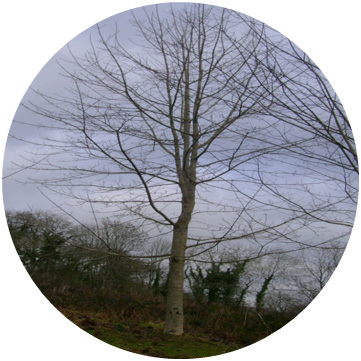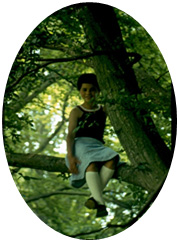CONTENTS
The use of metaphor
A Bolder of Disruption
Imagery as an art of communication
Wilful Waters
In Nature I See Me
Person to tree and tree to person conversations
The winter treesIn Honour of the Trees
The use of metaphor
The use of metaphor involves imaginative application of conceptual understand and offers a deeper and more unique expression of inner thoughts and feelings. The use of metaphorical language expands our capacity to share creatively through descriptive writing. Conceptual thoughts find new dimensions of communication within metaphoric scaffolding and thus illustrate conceptual ideas related to thoughts and feelings that might otherwise remain beyond a conscious means of successful communication.
| For I like a thorn have a contrasting ignorance and conceptual opposition to the blessings of the summer rose. |
A Bolder of Disruption
A rolling stone gathers no moss…….It’s hard unyielding form nurtures no-one.
A rolling boulder of disruption, brutally crushes all that falls beneath its’ descending force.
Yet the power of natural stillness can finally stop it on its headlong path,
And then boulder of fear is stopped and held fast.
There it sits and sinks into the mother earth below its standing weight;
Vibrant green moss grows innocently upon its solid form;
Animals may seek its shelter, and perch upon its height to gaze around at the surrounding sights.
The sun and rain wear it down into submission and even the smallest insects easily climb upon its mountainous summit.
It is only I that still stands daunted by its formidable presence where it blocks my path.
Surrounded by its magnitude, forlorn and insignificant, only I am captured within its fear-full demise.
I am no longer presented with an easy path carved by the boulder’s destruction.
Surrounded in an awesome stillness I find the courage to walk around it and continue on an unmarked journey.
No boldly marked passage only moment by moment footsteps within an unknown potential.
With nature as my only companion I am guided by the wisdom of her stillness,
And I feel free, at last, to experience the eternal love of my creator.
Sometimes what we see in nature seems to relate to our own feelings and our own disposition or desires. The following poem and accompanying pictures was a creative response to a gentle stroll and accompanying inner conversation with the natural environment. It presents how natural objects can inspire creative communication and divergent exploration of conceptual thinking.
Imagery as an art of communication
Creative writing encourages us to use imagery as a communicative art form. Metaphor, Symbolism, Simile, and Allusion provide different ways of communicating an abstract thought or process.
Metaphor– a descriptive word or phrase that is imaginatively rather than literally applicable.
Simile– a descriptive word or phrase that compares a similar physical and/or conceptual concept within one thing with something different.
Allusion – an indirect or subtle reference to a particular descriptive aspect of perception. (Not to be confused with the word illusion meaning not real, entirely imagined.)
Symbolism – the use of a conventional symbol to represent or indirectly express a specific idea, feeling, concept or cognitive understanding.
Our sensory relationship with nature is often associated with our more complex inner aspects of personal experiences. The following poem is used to provide examples of different forms of Imagery:
Wilful Waters
The river now belongs to the fields and the fields currently belong to the river.
Trees decorate the watery plains and the hedges pattern the monotony.
The wilful waters are abandoned into a vast story of rotation.
Released from the resilient contours of a former bed,
Unable to focus on a foreseeable destination.
An excessive disposition now journeys towards an ill-defined freedom.
The power is that of obscurity, an escape from conformity;
Confusion defies logic and eludes preconceived vision
To claim a surreal definition of separation.
Yet it is rebellion that defines this creative inspiration
As liberty within images of isolation.
[The introduction to the book of Revelation presented as Literary Features in the English Standard Version – Study Bible presents the book of Revelation as an inspiring example of apocalyptic creative writing at is best. This last book in the bible is a wondrous example of complex imagery presented within a visionary narrative (story). This writing presents an advanced form of literary skill that surpasses our modern day media skills. Other books in the bible that also present advanced levels of literary interest are Job, Psalms and Proverbs.]
Sometimes what we see in nature seems to relate to our own feelings and our own disposition or desires.
In Nature I See Me
Like the rose my blossoming is short lived
And my beauty soon to be gone-
Surrendered to a thorny existence
Where deterrents wash over my passions.
And ill winds stiffen my structured form;
Until summer opens my delight
With sweet promises of a royal bouquet.
And fragrant colours command my heart to flower.
Like the wind I rush forth into any situation,
And I’ll be sure to moan and groan
When confined by systems of control.
And certain to wail pitifully
Within constricting structures of resistance.
Yet soon to sing with wondrous phrases
Amongst a creative freedom,
And bring to life with dancing movements
That which has a lifeless printed form.
Sometimes when we are in nature what we see brings us messages: A recent experience of the author is described as follows:- Quiet suddenly I saw a large hare strong and bold he was with his giant ears alert he ran not so quickly around and about in an area easily to be seen from where I was standing. This very unexpected and unusual encounter left a strong impression on my senses and my thoughts came forward to consider the possible message that nature was bringing to me. I conceded that although I like to act like the hare, it may be a time to consider the success of the tortoise who plodded on so happily with his faith that even slow steps could bring him successfully to the finishing line. With this simple philosophy and his conscientious endeavour the tortoise won the race, so maybe I can also find success even when my progress feels extremely slow.
• In a natural environment find a very special sensory experience that moves your senses, to see and feel something special that stirs your spirit.
• Using a pretend, or a cardboard picture frame, ‘take a picture’.
If this is provided by a specific object that can be carried bring it back to your work space and fill yourself with every aspect of your special experience. If it is not right or possible for any reason to bring your special sensory experience back to your work space then fill yourself with every aspect of your special experience that you can. When you feel you have attained your fullest benefit write down three words that best describe the most special qualities that were provided by your special experience. Find a listening partner and describe to him/her why each of your special words was chosen to describe your special sensory experience. Now choose one of your words and add another word to it to make a two word phrase then add another word to make a three word phrase and continue until you feel there are no more words to add. You may have a full sentence of a short phrase. Do the same extending activity, with each of the other two words you have chosen and to finish see if there is a way that the three written descriptions can be joined together into sentences or a short paragraph.
• Person to tree and tree to person conversations
An outdoor project could be to choose a special tree to befriend over the course of a period of time, anything from three days, three weeks three months or even a complete year. This project can embrace a wide spectrum of creative and expressive language activities e.g.tree meditation, tree identification, a tree project, a tree diary, art and crafts and design, e.g. bark rubbings, leaf prints, still drawing. Tree conversations – person to tree, and tree to person are a great inspiration for creative and expressive conversations.
The winter trees
And so the trees give up their worldly clothing
Their colourful illustration of living
Falls haphazardly on the ground around them.
They again return to their silent wisdom
Standing in their strength,
Showing us the stillness in the art of living,
And I remember why I admire them so.
In Honour of the Trees
Standing tall in your strength against time.
In silent unseeing observation,
Of generations growing from child into parenting.
The wind brings an ever moving creativity to your serenity,
Your roots remain secure in the abundance of a future potency,
You greet the ways of our days
But we rarely appreciate the longevity of your life giving presence.
Those unconditional fortunes
Given to a world of little gratitude and faint observations.
What have you seen that we still don’t understand?
What have we done to the natural lands?
Yet still the sun, the moon and the stars
Shine their blessings upon thee
As your leaves float on down the stream
Winter flows under your boughs once again.
As my life weakens with old age
Yours grows with everlasting maturity
Our reunion builds a rainbow across my lifetime,
As again I feel your companionship and my childhood.
[This poem was written when the author returned to a park that she had known as a favourite place, over 30 years earlier, in her childhood. There were several trees that she recognised from her childhood days. ]
The Great Oak
The silence still oak embraces the melody of the dawn
As the white dove caresses the morning sky
The swift swallow flirts with the wind
And the fragile butterfly passionately kisses each flower
I celebrate my aloneness as an illusion
That like a curtain can be swept aside
While I gaze through the window of my reality
And surrender into my togetherness with god
